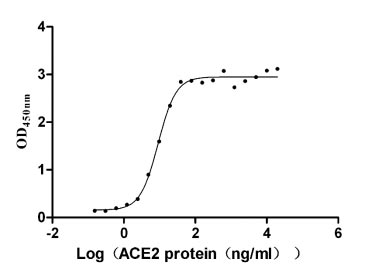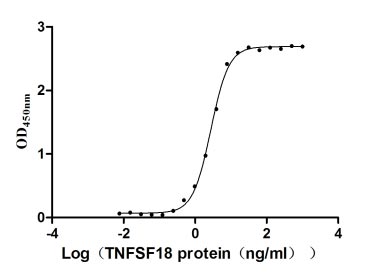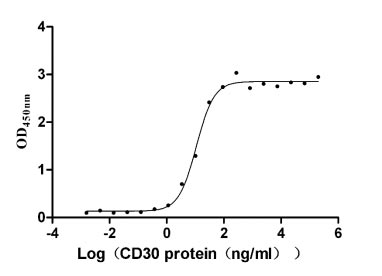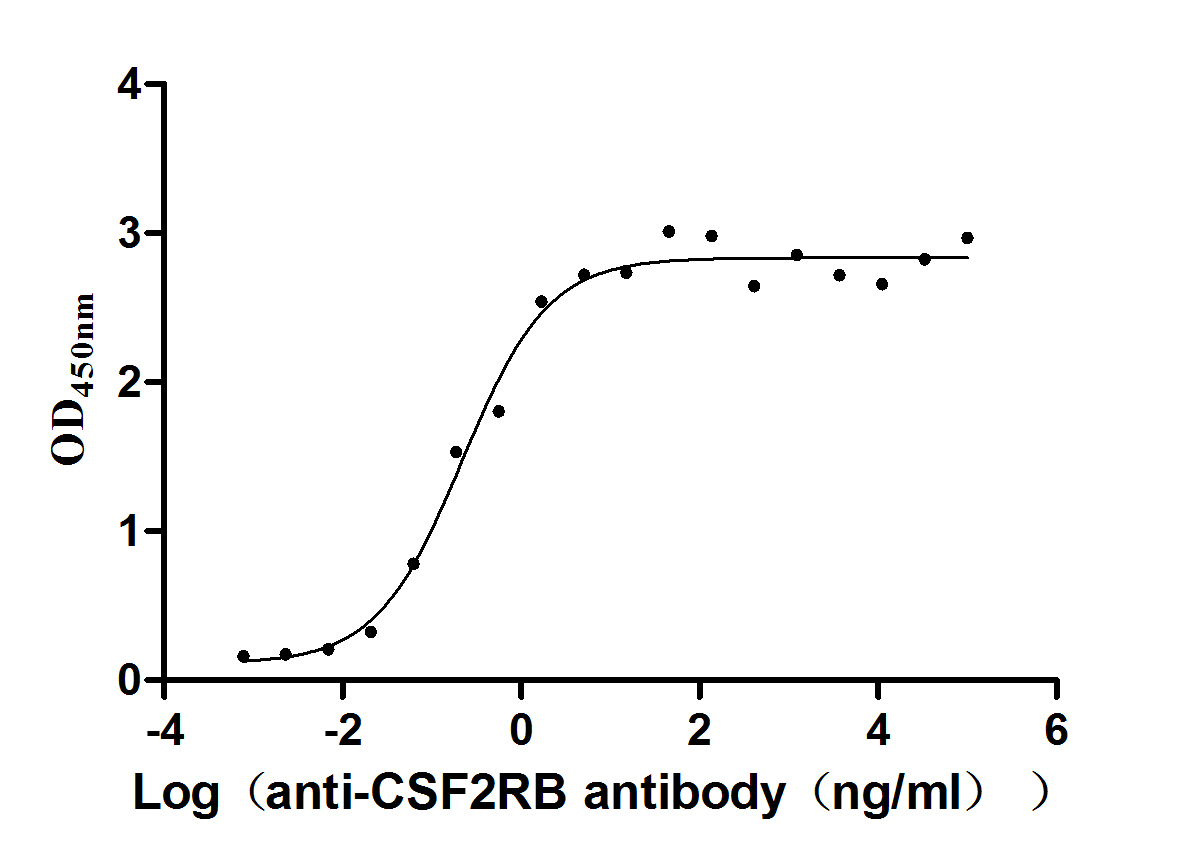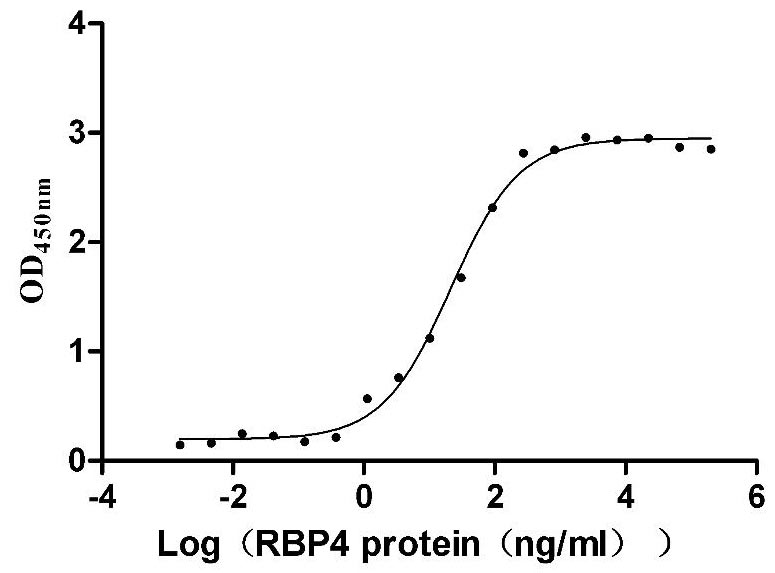Recombinant Human Glucose-6-phosphate 1-dehydrogenase (G6PD)
-
货号:CSB-YP009121HU
-
规格:
-
来源:Yeast
-
其他:
-
货号:CSB-EP009121HU
-
规格:
-
来源:E.coli
-
其他:
-
货号:CSB-EP009121HU-B
-
规格:
-
来源:E.coli
-
共轭:Avi-tag Biotinylated
E. coli biotin ligase (BirA) is highly specific in covalently attaching biotin to the 15 amino acid AviTag peptide. This recombinant protein was biotinylated in vivo by AviTag-BirA technology, which method is BriA catalyzes amide linkage between the biotin and the specific lysine of the AviTag.
-
其他:
-
货号:CSB-BP009121HU
-
规格:
-
来源:Baculovirus
-
其他:
-
货号:CSB-MP009121HU
-
规格:
-
来源:Mammalian cell
-
其他:
产品详情
-
纯度:>85% (SDS-PAGE)
-
基因名:G6PD
-
Uniprot No.:
-
别名:G6PD; G6PD_HUMAN; G6PD1; G6pdx; Glucose 6 phosphate 1 dehydrogenase; Glucose 6 phosphate dehydrogenase; Glucose 6 phosphate dehydrogenase, G6PD; Glucose-6-phosphate 1-dehydrogenase; MET19; POS10; Zwf1p
-
种属:Homo sapiens (Human)
-
蛋白长度:Full Length of Mature Protein
-
表达区域:2-515
-
氨基酸序列AEQVALSRT QVCGILREEL FQGDAFHQSD THIFIIMGAS GDLAKKKIYP TIWWLFRDGL LPENTFIVGY ARSRLTVADI RKQSEPFFKA TPEEKLKLED FFARNSYVAG QYDDAASYQR LNSHMNALHL GSQANRLFYL ALPPTVYEAV TKNIHESCMS QIGWNRIIVE KPFGRDLQSS DRLSNHISSL FREDQIYRID HYLGKEMVQN LMVLRFANRI FGPIWNRDNI ACVILTFKEP FGTEGRGGYF DEFGIIRDVM QNHLLQMLCL VAMEKPASTN SDDVRDEKVK VLKCISEVQA NNVVLGQYVG NPDGEGEATK GYLDDPTVPR GSTTATFAAV VLYVENERWD GVPFILRCGK ALNERKAEVR LQFHDVAGDI FHQQCKRNEL VIRVQPNEAV YTKMMTKKPG MFFNPEESEL DLTYGNRYKN VKLPDAYERL ILDVFCGSQM HFVRSDELRE AWRIFTPLLH QIELEKPKPI PYIYGSRGPT EADELMKRVG FQYEGTYKWV NPHKL
-
蛋白标签:Tag type will be determined during the manufacturing process.
The tag type will be determined during production process. If you have specified tag type, please tell us and we will develop the specified tag preferentially. -
产品提供形式:Lyophilized powder
Note: We will preferentially ship the format that we have in stock, however, if you have any special requirement for the format, please remark your requirement when placing the order, we will prepare according to your demand. -
复溶:We recommend that this vial be briefly centrifuged prior to opening to bring the contents to the bottom. Please reconstitute protein in deionized sterile water to a concentration of 0.1-1.0 mg/mL.We recommend to add 5-50% of glycerol (final concentration) and aliquot for long-term storage at -20℃/-80℃. Our default final concentration of glycerol is 50%. Customers could use it as reference.
-
储存条件:Store at -20°C/-80°C upon receipt, aliquoting is necessary for mutiple use. Avoid repeated freeze-thaw cycles.
-
保质期:The shelf life is related to many factors, storage state, buffer ingredients, storage temperature and the stability of the protein itself.
Generally, the shelf life of liquid form is 6 months at -20°C/-80°C. The shelf life of lyophilized form is 12 months at -20°C/-80°C. -
货期:Delivery time may differ from different purchasing way or location, please kindly consult your local distributors for specific delivery time.Note: All of our proteins are default shipped with normal blue ice packs, if you request to ship with dry ice, please communicate with us in advance and extra fees will be charged.
-
注意事项:Repeated freezing and thawing is not recommended. Store working aliquots at 4°C for up to one week.
-
Datasheet :Please contact us to get it.
相关产品
靶点详情
-
功能:Catalyzes the rate-limiting step of the oxidative pentose-phosphate pathway, which represents a route for the dissimilation of carbohydrates besides glycolysis. The main function of this enzyme is to provide reducing power (NADPH) and pentose phosphates for fatty acid and nucleic acid synthesis.
-
基因功能参考文献:
- Study identified G6PD as a downstream target of miR1 in pituitary tumor cells and suggested that G6PD plays important roles for mediating the inhibitory effect of miR1 on the growth of pituitary tumor cells. PMID: 30272333
- Study demonstrated that high G6PD expression is a poor prognostic factor in bladder cancer, and the levels of G6PD expression increase with increasing tumor stage. Patients with bladder cancer with high G6PD expression had worse survival rates compared with those with lower G6PD expression in resected tumors. PMID: 30066842
- G6PD-dificient patients were found to have an increased risk for cancers, especially for brain tumor; higher tumor G6PD expression was associated with poor patient survival in low grade glioma (LGG), but not in Glioblastoma multiforme. A prognostication model using expression levels of G6PD and 9 related genes (PSMA2, PSMB8, SHFM1, GSS, GSTK1, MGST2, POLD3, MSH2, MSH6) could independently predict LGG patient survival. PMID: 29845423
- G6PD contributes to HCC migration and invasion of hepatocellular carcinoma cells by inducing epithelial-mesenchymal transition through activation of signal transducer and activator of transcription 3 PMID: 29471502
- Study provided detailed genotypes of G6PD deficiency in Guangdong province with minorities populations and identified various point mutations in G6PD gene. PMID: 30077011
- Results showed that not only G6PD expression but also G6PD activity was significantly lowered along with 3D MCF-7 cells culture time. PMID: 29291545
- An aggregate analysis of mosaic G6PD expression in two distinct ethnic cohorts has been reported. PMID: 29240263
- Proportion of mutational types in G6PD and the degree of enzyme activity change in various mutational types were found in the neonates of Fujian Province. Three most common mutation types were c.1376G > T, c.1388G > A, and c.95A >G. PMID: 30045279
- Chemical inhibitors against SIRT2 suppress G6PD activity, leading to reduced cell proliferation of leukaemia cells, but not normal hematopoietic stem and progenitor cells. Importantly, SIRT2 is overexpressed in clinical acute myeloid leukaemia samples, while K403 acetylation is downregulated and G6PD catalytic activity is increased comparing to that of normal control. PMID: 27586085
- Treatment of erythrocytes with Bay 11-7082, parthenolide or DMF led to concentration-dependent eryptosis resulting from complete depletion of GSH. GSH depletion was due to strong inhibition of G6PDH activity. PMID: 27353740
- Studies indicate that the activities of glucose-6-phosphate dehydrogenase (the rate-limiting enzyme in the pentose shunt) and glucose flux through the shunt pathway is increased in various lung cells including, the stem cells, in pulmonary hypertension. PMID: 29047080
- These findings revealed a novel glucose metabolism-related mechanism of PAK4 in promoting colon cancer cell growth, suggesting that PAK4 and/or G6PD blockage might be a potential therapeutic strategy for colon cancer. PMID: 28542136
- Aggregated across all genotypes, we find that increasing levels of G6PD deficiency are associated with decreasing risk of cerebral malaria, but with increased risk of severe malarial anaemia. PMID: 28067620
- We concluded that the MeltPro G6PD assay is useful as a diagnostic or screening tool for G6PD deficiency in clinical settings PMID: 27495838
- The glucose-6-phosphate dehydrogenase enzymatic deficiency was significantly higher in males compared to females in Burkina Faso. (Review) PMID: 29169341
- This work expands the current understanding of the biochemical underpinnings of G6PD variant pathogenicity. PMID: 28297664
- This study assessed quantitatively the hemolytic risk with tafenoquine in female healthy volunteers heterozygous for the Mahidol(487A) glucose-6-phosphate dehydrogenase (G6PD)-deficient variant versus G6PD-normal females. PMID: 28749773
- only in the case of G6PD and TALDO, the ratio of BrdU incorporation to DNA was significantly changed. The presented results together with our previously published studies illustrate the complexity of the influence of genes coding for central carbon metabolism on the control of DNA replication in human fibroblasts, and indicate which of them are especially important in this process. PMID: 28887160
- Data suggest that G6PD PT materials can be stored at 4 degrees C and used for up to one month and can be stored at -20 degrees C for one year and yield >90% enzyme activity. Exposure to warm temperatures, especially with elevated humidity, should be avoided. Desiccant should always be used to mitigate humidity effects PMID: 28479150
- We found that 2 G6PD variant genotypes were associated with elevated sTfR concentrations, which limits the accuracy of sTfR as a biomarker of iron status in this population. PMID: 28768839
- immature reticulocytes (CD71+) targeted by P. vivax invasion are enzymatically normal, even in hemizygous G6PD-Mahidol G487A mutants; thus, allowing the normal growth, development, and high parasite density in severely deficient samples PMID: 28591790
- review of the state of the art in G6PD deficiency, describing 217 mutations in the g6pd gene; also compiled information about 31 new mutations, 16 that were not recognized and 15 more that have recently been reported; found that class I mutations have the most deleterious effects on the structure and stability of the protein PMID: 27941691
- We now provide an additional evidence form Palestinian G6PD-deficient subjects for a possible role of 3' UTR c.*+357 A>G, c.1365-13T>C, and/or c.1311C>T polymorphism for G6PD deficiency, suggesting that not only a single variation in the exonic or exonic intronic boundaries, but also a haplotype of G6PD should considered as a cause for G6PD deficiency. PMID: 28059001
- This work reviews and discusses rationales and challenges of G6PD screening program in Gaza Strip. We advocate adopting a national neonatal G6PD screening program in Gaza Strip to identify children at risk and promote wellness and health for Palestine. PMID: 27064064
- From the study it appears that Ala44Gly and Gly163Ser are the most common G6PD mutations in Dhaka, Bangladesh. This is the first study of G6PD mutations in Bangladesh. PMID: 27880809
- the anti-cervix cancer mechanism of G6PD deficiency may be involved with the decreased cancer cells migration and proliferation ability as a result of abnormal reorganization of cell cytoskeleton and abnormal biomechanical properties caused by the increased reactive oxygen species. PMID: 27217331
- A novel pathogenic missense mutation in G6PD is associated with BCGitis in two patients with G6PD deficiency. PMID: 27914961
- Results show that G6PD mutations in the Mexican population affect the catalytic properties and structural parameters regardless of the distance from the active site changing the three-dimensional structure which correlates with a more severe clinically phenotype. Also, the global stability of the protein is affected. PMID: 27213370
- G6PD may function as an important regulator in development and progression of esophageal squamous cell carcinoma by manipulating STAT3 signaling pathway PMID: 26250461
- One novel mutation (p.Cys385Gly, labeled G6PD Kangnam) and two known mutations [p.Ile220Met (G6PD Sao Paulo) and p.Glu416Lys (G6PD Tokyo)] were identified. glucose-6-phosphate dehydrogenase (G6PD) PMID: 28028996
- Increased advanced lipoxidation end products generation was associated with decreased G6PD activity in mild non-proliferative diabetic retinopathy. PMID: 27916496
- Increased G6PD expression is associated with triple-negative breast cancer. PMID: 26715276
- Glucose-6-phosphate dehydrogenase variants are associated with glucose-6-phosphate dehydrogenase deficiency. PMID: 26827633
- Common G6PD variant identification using Amplification resistant modified system (ARMS)-PCR in a Tunisian population. PMID: 27029726
- erythrocyte G6PD and their correlation with GSH provides evidence of a higher oxidative stress in old age population PMID: 26711700
- Data indicate a tumor suppressor-like function of Bcl-2 associated athanogene 3 (BAG3) via direct interaction with glucose 6 phosphate dehydrogenase (G6PD) in hepatocellular carcinomas (HCCs) at the cellular level. PMID: 26621836
- This is the first report of G6PD deficiency among Chinese Hakka population in Jiangxi province. PMID: 26823837
- These findings suggest that the increased susceptibility of the G6PD-knockdown cells to viral infection was due to impaired NF-kappaB signaling and antiviral response mediated by HSCARG. PMID: 26694452
- differential expression in children with allergic asthma PMID: 25979194
- G6PD deficiency affects the cellular inflammatory response and the decreased TNF-alpha-mediated antiviral response in G6PD-kd A549 cells is a result of dysregulated NOX/MAPK/NF-kappaB/COX-2 signaling PMID: 27097228
- study demonstrated that G6PD molecular deficiency was not associated either with clinical ischemic stroke PMID: 26840990
- Transgenic mice moderately overexpressing G6PD have higher levels of NADPH, lower levels of ROS-derived damage, and better protection from ageing-associated functional decline, including extended median lifespan in females. PMID: 26976705
- Overexpression of G6PD is associated with high risks of recurrent metastasis in primary breast carcinoma. PMID: 26607846
- G6PD glycosylation is increased in human lung cancers. Glycosylation activates G6PD activity and increases glucose flux through the PPP, thereby providing precursors for nucleotide and lipid biosynthesis, and reducing equivalents for antioxidant defense. PMID: 26399441
- To understand the sporadic Alzheimer's disease, the writer of this paper thinks that, looking into a crystal ball might not yield much of a benefit but glucose-6-phosphate dehydrogenase deficiency could effortlessly give some clues. PMID: 26004559
- Mutation of G6PD is associated with G6PD deficiency in Chinese population. PMID: 26829728
- G6PD deficiency is an example of balanced polymorphism, in which high rate of mortality caused by this disorder is offset by the protection that it offers against Plasmodium falciparum malaria PMID: 26139767
- G6PD, GGCT, IDH1, isocitrate dehydrogenase 2 (NADP+,mitochondrial) (IDH2) and glutathione S-transferase pi 1(GSTP1), five of the critical components of GSH pathway, contribute to chemoresistance. PMID: 25818003
- Proteomics results showed that G6PD was highly expressed in cervical cancer cells and its down regulation reduced reduced the capacity of HeLa cells to migrate and invade in vitro. PMID: 25633909
- Studied G6PD mutations present in a Sri Lankan population and their association with uncomplicated malaria. PMID: 25885177
显示更多
收起更多
-
相关疾病:Anemia, non-spherocytic hemolytic, due to G6PD deficiency (NSHA)
-
亚细胞定位:Cytoplasm, cytosol. Membrane; Peripheral membrane protein.
-
蛋白家族:Glucose-6-phosphate dehydrogenase family
-
组织特异性:Isoform Long is found in lymphoblasts, granulocytes and sperm.
-
数据库链接:
HGNC: 4057
OMIM: 300908
KEGG: hsa:2539
STRING: 9606.ENSP00000377192
UniGene: Hs.461047
Most popular with customers
-
Recombinant Human SARS coronavirus Spike glycoprotein (S), partial (Active)
Express system: Mammalian cell
Species: Human SARS coronavirus (SARS-CoV) (Severe acute respiratory syndrome coronavirus)
-
Recombinant Human Tumor necrosis factor ligand superfamily member 18 (TNFSF18), partial (Active)
Express system: Mammalian cell
Species: Homo sapiens (Human)
-
Recombinant Human 5'-nucleotidase (NT5E) (Active)
Express system: Mammalian cell
Species: Homo sapiens (Human)
-
Recombinant Human Tumor necrosis factor ligand superfamily member 8 (TNFSF8), partial (Active)
Express system: Mammalian cell
Species: Homo sapiens (Human)
-
Recombinant Human Cytokine receptor common subunit beta (CSF2RB), partial (Active)
Express system: Mammalian cell
Species: Homo sapiens (Human)
-
Recombinant Human G-protein coupled receptor family C group 5 member D (GPRC5D)-VLPs (Active)
Express system: Mammalian cell
Species: Homo sapiens (Human)
-
Recombinant Mouse Transthyretin (Ttr) (Active)
Express system: Mammalian cell
Species: Mus musculus (Mouse)
-
Recombinant Mouse Retinol-binding protein 4 (Rbp4) (Active)
Express system: Mammalian cell
Species: Mus musculus (Mouse)


